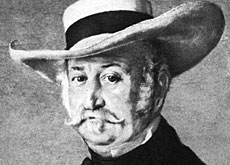“Gold rush” Sutter had Swiss ties

In the United States, John A Sutter has gone down in history as the man who inadvertently sparked off the Californian gold rush of 1848.
But the Swiss remember Sutter as an adventurer from the town of Burgdorf, who ran out on his wife and children, leaving them to face his angry creditors.
To mark the bicentenary of Sutter’s birth on February 23, 1803, the castle museum of Burgdorf in canton Bern is staging an exhibition on his life.
In January 1848 gold was discovered in Coloma, California, on land owned by Sutter. He wanted to build a sawmill for his timber business and had employed James W Marshall to oversee its construction.
It was Marshall who brought him news of the discovery – he handed two pale ounces to an astonished Sutter, who decided to conduct his own tests on the substance.
“After having proved the metal with aqua fortis, which I found in my apothecary shop, and read the long article ‘gold’ in the Encyclopedia Americana, I declared this to be gold of the finest quality of at least 23 carats,” wrote Sutter in his diary.
The two men agreed to keep the find a secret but were unfortunately overheard by one of Sutter’s clerks.
Within weeks, the gold rush had started – the land was besieged by thousands of fortune seekers.
Humble beginnings
In 1848 Sutter was a self-made man. His successful businesses included a tannery, cattle ranch and distillery. Part of his fortune stemmed from providing refuge and services to new immigrants to California.
Few would have guessed that just a few years earlier, Sutter had been a small-town cloth merchant called Johann.
Born in Germany, Johann August Sutter’s connection with Switzerland began when he was sent to school near Neuchâtel, aged 15.
He eventually took Swiss nationality.
It was love that later led the young Johann to settle in Burgdorf, which was his wife’s hometown.
Two years after his marriage, Sutter decided it was time to branch out and set up business on his own. He opened a shop selling fine cloth.
Financial difficulties
However, things did not quite go according to plan and Sutter was soon in financial trouble.
“Sutter tried to sell fine cloth and used the best machinery to produce it. Naturally in the Emmental, people didn’t like this very much. They wanted something good but not too expensive,” explains Rene Mathyer, a tour guide in Burgdorf.
Sutter’s debts began to pile up – by 1834 he owed the small fortune of SFr37,000 ($27,500) to a number of creditors. At the Burgdorf museum, visitors can see a copy of the official arrest warrant for Sutter.
With no means of satisfying his creditors, Sutter was faced with bankruptcy and the prospect of a jail sentence.
He decided the only way out was to flee Burgdorf, and he disappeared in June 1834, leaving behind his wife and four young children.
California dreaming
In July 1834 Sutter arrived in New York by ship. Now calling himself John, he decided his future lay in California.
To qualify for a land grant in California, which was then part of Mexico, he took on Mexican nationality.
The Mexican government duly gave him nearly 50,000 acres in a prime location at the confluence of two rivers. In homage to the Swiss home he had left behind, he called his estate Nuovo, or New, Helvetia.
By 1848 – the year gold was discovered in Coloma – Sutter was a rich man with diverse business interests.
Gold rush
But within weeks of the discovery, his once fertile lands became a barren wasteland, overrun by fortune-seeking squatters.
Sutter’s own Californian dream turned bitter. While he and his family continued to influence the development of northern California – his son was responsible for laying the foundations of the modern city of Sacramento – Sutter never quite regained his former glory.
In 1850 he was finally reunited with his wife and children, after a 16-year separation.
A few years later, in the 1860s, Sutter tried to make good his losses from the gold rush days by claiming compensation from the federal government.
In a series of lawsuits, he argued he should be reimbursed for helping to colonise the western state and for the loss of his lands to gold diggers.
On June 16, 1880, Congress adjourned without passing legislation, which could have paved the way to a financial settlement.
The shock must have helped send Sutter to his grave. He died just two days later, aged 77.
swissinfo, Faryal Mirza
John A Sutter is a well-known figure in the history of the United States.
The discovery of gold on his land in 1848 sparked off the infamous Californian Gold Rush.
Until 1834, John was Johann August Sutter, a cloth merchant living in the Swiss town of Burgdorf, who had to flee the country after creating a mountain of bad debts.
The Sutter exhibition at the Burgdorf castle museum runs until October 31.

In compliance with the JTI standards
More: SWI swissinfo.ch certified by the Journalism Trust Initiative
You can find an overview of ongoing debates with our journalists here . Please join us!
If you want to start a conversation about a topic raised in this article or want to report factual errors, email us at english@swissinfo.ch.